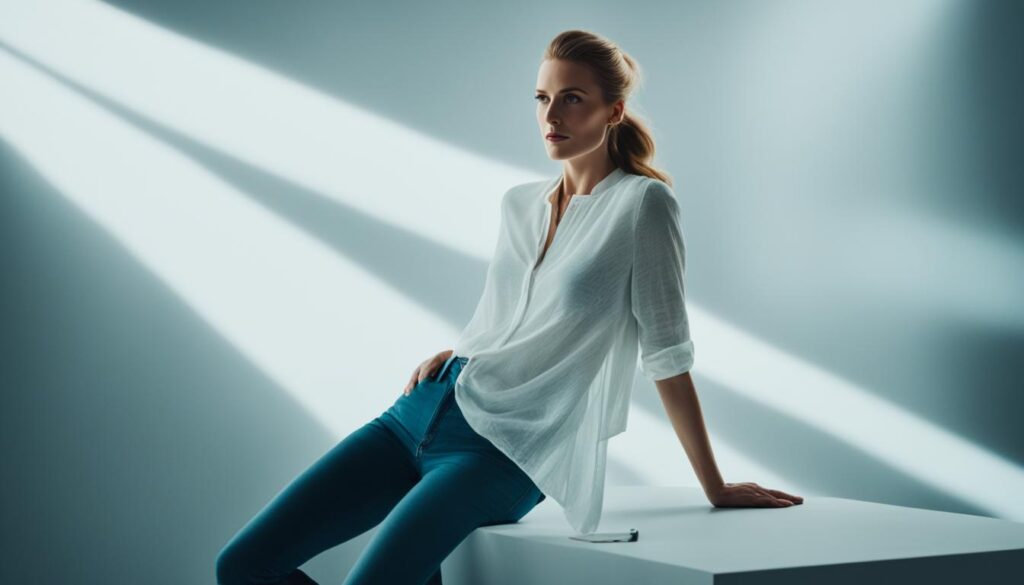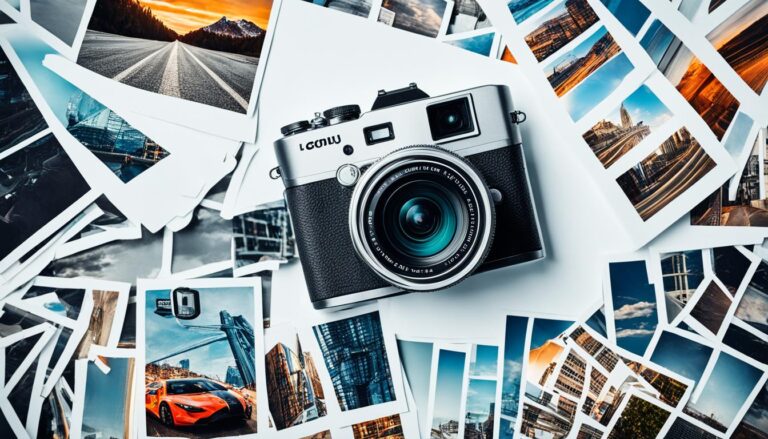Crafting Visual Narratives: The Role of Storytelling in Commercial Photography
Crafting Visual Narratives: The Role of Storytelling in Commercial Photography
Imagine you’re walking through an art gallery. Your eyes slide over images and then, one picture stops you. It’s not just a photo; it’s a story in a frame. It grips your feelings fiercely. This power of visual storytelling in marketing is what creators aim for.
In commercial photography’s competitive world, making visual content that touches hearts is key. A narrative that connects doesn’t only show a product. It knits stories that pull you in, making you more than a viewer. Through storytelling, commercial photography links commerce with real connection. It turns passive viewers into active participants in the story.
Think about how a familiar scent or an old song can take you back in time. In the same way, a well-done image breaks through time and space. It makes you feel its stories as personal and true. They beckon you to look closer, listen, and feel deeply. Crafting visual stories is an art. It’s a deep chat between the photo and you.
Key Takeaways
- The power of storytelling in commercial photography offers more than product shots; it creates stories that connect and stay with us.
- Successful visual storytelling transforms the viewer’s role from observer to participant, enhancing emotional engagement.
- Visual narratives can evoke memories and emotions, making storytelling a key strategy in marketing.
- A visual storyteller has the ability to capture complex ideas and turn them into compelling, easy-to-understand visual content.
- Crafting visual content that resonates is crucial in developing a brand that speaks to and moves its audience.
Embracing the Power of Imagery in Commercial Branding
In the digital age, imagery in branding is key. Brands now invest more in high-quality imagery. This isn’t just decoration but a vital part of impactful branding. Images must catch the eye and resonate with the audience.
Visual storytelling through photography is central to commercial branding. Professional photographers create compelling visual narratives. They tell a story, evoke an experience, or dream through skillful use of light and composition. Their work offers an immersive storytelling experience, driving emotional responses and loyalty.
Nowadays, consumers want real connections and stories they can relate to. Captivating visuals share complex ideas simply, unfolding them as visual stories. These stories not only engage but also inspire and drive action. Let’s explore the impact of imagery on consumer perception and brand identity:
The core of connectivity and engagement today lies in visuals. These images tell a story instantly, showcasing a brand’s ethos and tapping into our love for stories.

Navigating changes in commercial visualisation can be challenging. But, it offers a chance to make your brand stand out. Use visuals that tell a rich story. Your brand won’t just be seen but also felt and remembered. Let your branding journey use imagery that touches your customers’ hearts, turning first-time viewers into lifelong fans.
In sum, the commercial branding world is dynamic, offering many chances for iconic visuals. Your job, whether you’re a creator, brand steward, or marketer, is to unlock the potential of visual stories. Captivate your customers with imagery that shares your brand’s story in the most compelling and authentic way.
Decoding the Impact of Professional vs. Non-Professional Photography
Choosing between professional and amateur photography isn’t just about looks. It’s about telling your brand’s story in the best way. This decision can change how people see and connect with your brand.
The Upscale Allure of Professional Photography
High-quality professional photos make brands stand out. They show clear images, perfect angles, and beautifully told stories. Experienced photographers bring skill and instinct, making images feel trustworthy and high-end. This boosts a brand’s image and appeal.
The Authentic Charm of Amateur Imagery
Amateur photos have a special, real-life charm. They show genuine moments and real people, making them very relatable. These photos capture everyday life artfully, building a strong emotional bond with viewers.
Let’s delve into the differences between professional and amateur photography:
| Aspect | Professional Photography | Amateur Photography |
|---|---|---|
| Image Quality | High-resolution, meticulously edited, perfect lighting | Natural lighting, minimal editing, original textures |
| Aesthetic Approach | Stylised compositions, tailored setups | Organic compositions, spontaneity |
| Storytelling | Crafted to convey a brand’s message with clarity | Professional feel inspires confidence and credibility |
| Impact on Audience | Professional feel, inspires confidence and credibility | Relatable content that may stimulate a sense of belonging |
| Typical Use-Cases | Advertising campaigns, editorial content, corporate branding | Social media, community building, relatable marketing |
Your brand’s story can be told through either professional or amateur photos. It’s about choosing the right style for your message. This choice should be based on the story you want to tell and how you want to connect with your audience.
Digital Advancements and The Democratisation of Photography
Thanks to digital advancements in photography, how we create and share photos has changed for the better. Now, high-quality mobile phone cameras are in many people’s hands, making photography accessible to everyone. There is no need for costly equipment; with a smartphone, anyone can take and share photos easily.
Social media platforms have become powerful for sharing images. They help user-generated content shine in marketing. Not only do these platforms help budding photographers, but they also create new paths for marketing and connecting with communities through photos. Photos are now key in telling stories and interacting with brands, from local happenings to worldwide campaigns.
User-generated content is now a big part of marketing plans. Authentic and relatable photos often mean more than professional ones. These real-life pictures show true consumer experiences, helping build trust and connect with people globally.
| Advancements | Impact on Professional Market | Impact on Consumer Market |
|---|---|---|
| High-Quality Mobile Cameras | New niches for professional photography services | Everyone is a potential photographer |
| Social Media Platforms | Professional portfolio diversification | Amplified sharing and networking capabilities |
| User-Generated Content | More raw and authentic brand material for marketing | Consumers actively participate in branding narratives |
| Real-Time Marketing | Immediate response and adaptation to market trends | Direct engagement and feedback from brands |
Your smartphone is a powerful tool for creativity and connection. It lets you be part of a community engaged through photography. Whether it’s a beautiful scene or a spontaneous moment, your photos add to the rich visual story of today’s world.
User-Generated Content: Authenticity Fuels Brand Loyalty
User-generated content (UGC) is key in today’s marketing. It strengthens brand loyalty and trust. It isn’t just a trend but a movement. Here, mobile photography is crucial. By using UGC, you’re showing real experiences. This invites customers to join your brand’s story.
Companies using UGC show they’re genuine. Seeing real people use products in daily life boosts trust. It’s not just about getting customers to share. It’s about creating a strong community around your brand. This enhances your brand’s value and loyalty.
Establishing Trust through Customer Snaps
Customer pictures are the new digital thumbs-up. Encouraging customers to take casual photos with your products boosts community feeling. It’s actual people, not models, who connect with your audience. These snaps tell personal stories. They build a stronger bond.
Monetising the Mobile Photography Phenomenon
Candid smartphone photos hold unseen value. Adding mobile photography to your strategy monetises these images. It brings authenticity led by customers. UGC can lower marketing costs. It allows for cheaper yet effective campaigns.
Now, consumers are creators too. Their content boosts engagement and loyalty. Their genuine visuals tell your brand’s story. They bring the trust consumers look for. It’s time to embrace UGC. It will bring trust, authenticity, and loyal customers.
Visual Storytelling in Motion: Capturing More than Just Moments
Visual storytelling in motion isn’t just about capturing a single moment. It’s about creating photo stories that are full of life and emotion. When you get into storytelling photography, you start to see how different moments can come together. They tell a story that’s rich and full of color. This art needs you to find those special moments that really speak. You have to catch them in a way that feels real and deep.

By blending narrative photography with lively scenes, you make stories that grab people’s attention. Your camera becomes more than a tool; it’s your voice for storytelling. Every time you take a picture, you’re adding to your story. This way, you fill your photos with life. This makes people feel like they’re right there, feeling the breeze or the tension in the air.
The key to evoking emotions with images is in the little things. It could be how twilight looks in the city, the laugh lines on someone’s face, or a single person set against nature. These details add up to tell a deep, emotional story. Your use of light and shadow invites people to come closer. They get pulled into the story you’re telling.
Remember, visual storytelling is not just about snapping a photo. It’s about taking a photo. You purposefully combine elements that stir emotions. This dedication makes you see beyond the obvious. It invites you to find something deeper in your shots. This changes you from just seeing to telling powerful stories.
The Art and Science of Narrative Photography
The science of narrative photography mixes technical skills with the ability to tell a story. As a visual artist, you can share human experiences through your lens. It is about composing tales with light and using techniques to grab the viewer’s attention and make them feel something deep. Your camera is not just for taking pictures. It captures the essence of emotions that touch the soul.

Great narrative photography starts with knowing how to use light. Light lets you paint scenes and emotions, picking out details and focusing on the story’s heart. Light and shadow play together, giving photos life.
Composing Tales with Light and Shadow
Working with light, you tell stories visually. Your skills in arranging photos are like words in a book. The mix of light and dark makes each photo a story chapter. Highlights and shadows set the mood, silently but powerfully affecting the image.
Editing Images for Enhanced Visual Rhythm
Editing for storytelling is next. Here, you tune the story’s rhythm, making sure each part matches the story’s core. Editing isn’t just fixing colours or spots. It’s about choosing each detail to build up the story. This is where the magic of your story gets fine-tuned, turning into a memorable and powerful piece.
The blend of light, shadow, and editing creates your final image—a frame that tells grand tales. Each story you capture is your mark on the art, leaving a legacy that combines science and the heart of photography.
The Magnetism of Immersive Storytelling Photography
Discover the world of immersive storytelling photography. Each picture connects you to a story, making you feel part of it. This kind of art shares deep stories through images. It makes you see and feel the tale, making narrative photography special.
Picture a gallery full of captivating photo narratives. Every image is a doorway to a story meant to move and inspire you. These photos capture life and emotions in a way that stays with you. They do more than just show art; they touch your feelings deeply.
“Photography is the beauty of life, captured.” – Tara Chisholm
Storytelling photography isn’t just about taking pictures. It’s using light, subject, and timing to bring photos to life. A photo’s power can make you feel deep emotions. That connection lets you experience the story, not just see it.

The strength seen in these photos comes from the photographers’ detailed work. They turn ordinary moments into captivating stories. Their pictures make you think and feel differently about the world.
When you see these images, let them pull you into their magic. They show the photographers’ skills. Immersive storytelling photography balances beautiful art with meaningful stories. It invites you to explore and discover more in each image.
In today’s world, the camera tells powerful stories. It captures engaging human stories that connect globally. You’re no longer just watching; you’re part of the corporate saga imaging. You see a series of visuals that tell the story of brands and their products.
Envisioning the Corporate Saga through Lenses
Every brand has its own story. Through the lens of a talented photographer, these stories come to life in clear detail. It’s more than just pretty pictures; it’s about crafting visual narratives showing a company’s spirit and customer journey. One photo can convey a lot, turning a corporate message into a visceral visual connection you instantly get.
From Visuals to Visceral: Engaging the Human Story
In storytelling’s role in commercial photography, each image might start a conversation with you. Photographers capture those silent, emotional moments, creating a link between the brand and you. This invites an intimate understanding that’s more than just buying and selling. It’s here that brand storytelling moves beyond being commercial to touching hearts, making each story feel personal and connective.
Photographers blend storytelling elements like composition, light, and crucial moments. They tell stories that are deeply human. This turns images into invitations—invitations to see your own stories and hopes reflected in the commercial sphere.
Strategies for Evocative Storytelling Through the Camera
Photography is an art form that requires more than skills. It requires a creative eye that turns storytelling photography ideas into vivid images that tell stories. Here are the essentials for improving your photography as a storytelling medium.
To excel in visual storytelling, think of the scene as an artist sees a blank canvas. Each element you capture should add to the overall picture. You’re not just taking photos; you’re storytelling through camera lenses. Let’s look at how to craft stories that stick with people.
1. Patience and Observation
The best stories come from waiting for the perfect moment. Take your time to look around. Patience brings shots that naturally show visual narrative techniques.
2. Engage with the Subject
Get to know your subjects. Talking to those you’re photographing, whether in portraits or on the street, leads to real and moving pictures. It’s key for truthful storytelling.
3. Exploring Vantage Points
Don’t be afraid to change angles and viewpoints. A small change can show a story in a new light. It adds exciting details to your shots.
| Technique | Role in Storytelling | Outcome |
|---|---|---|
| Deliberate Planning | Aligns the narrative intention with the visual outcome | Intentional and meaningful imagery |
| Familiarising with Subject | Invites authenticity and rapport | Genuine and relatable visuals |
| Varied Angles | Revels unexplored perspectives | Dynamic and enriched visual tales |
| Lighting Mastery | Sets mood and atmosphere | Emotionally charged narrative |
| Moment Capturing | Encapsulates the essence of the instance | Powerful and poignant stories |
Use these methods, and your photos will tell stories that draw people into the scene. This is where photography as a storytelling medium reaches its highest goal.
Leveraging Light, Composition and Colour in Storytelling
Narrative photography is an art that blends light, composition, and colour. Together, they shape stories, connect with emotions, and enhance a photo’s message. Understanding how these elements work together is key. It involves seeing how they influence storytelling and visual communication.
Moulding Perceptions with Light
Light brings a special magic to photography. It transforms scenes with effects from soft morning light to dramatic shadows. It shapes how we see and feel about an image. By using light creatively, photographers highlight details or create mystery. This way, they tell captivating stories.
Composition: The Unspoken Story
A photo’s composition tells its own story. It arranges elements in a frame, guiding the viewer’s eye. Techniques like the rule of thirds or symmetry help. They control how the story unfolds visually, without words.
Colour Psychology in Photographic Storytelling
Colour evokes emotions and shapes our response to images. It’s more than just beauty; it controls mood and feeling. In photography, careful colour choice boosts the story’s impact. It makes us feel a certain way, pointing to the deeper meaning.
In narrative photography, every detail is carefully chosen. Light, shadow, composition, and colour come together. They don’t just show a scene; they tell a vivid story. This story can move people, shape perceptions, and touch hearts. The silent elements of a photo work together, creating a rich experience that speaks to our emotions.
| Element | Aspect | Impact on Storytelling |
|---|---|---|
| Light | Direction & Quality | Setting tone and mood, highlighting subjects, creating contrast |
| Composition | Rule of Thirds, Balance, Framing | Directing the viewer’s attention, depicting relationships between elements |
| Colour | Hue, Saturation, Brightness | Inducing emotions, symbolising concepts, establishing an atmosphere |
Innovative Photography Techniques for a New Era of Advertising
As advertisers, you’re always looking for innovative photography techniques to make your brand stand out. The new era of advertising measures campaign success through visual metaphors in photography. Combining art and technology grabs the audience’s attention in new ways.
Modern advertisers are pushing beyond the usual with narrative photography advancements. It’s as important to focus on ‘how’ you tell your story as on ‘what’ the story is. Imagine adding new photography ideas to your toolkit. Think about how this could change how people see your brand.
The new wave in contemporary advertising strategies mixes images with interactive tech to create dynamic stories. Your campaigns should be seen as a canvas. Here, advertising through visual narratives not only sells a product but also tells a story that draws in today’s consumer.
| Technique | Benefits | Use Case Examples |
|---|---|---|
| 360° VR Photography | Immersive user experience showcases environments in full detail | Virtual tours for real estate, interactive product demonstrations |
| High-dynamic-range Imaging (HDR) | Ensures vibrant information, highlights and shadows without under/overexposure | Automotive advertising, capturing intricate product designs |
| Cinemagraphs | Fuses subtle movement in still photos, creates a mesmerising effect | Social media campaigns, and e-mail marketing to increase click-through rates |
| Augmented Reality (AR) Integration | Enhances real-world with virtual elements; interactive and engaging | Brand mascots in Print Ads, interactive billboards |
| Drones and Aerial Photography | Provides a unique perspective, capturing the grand scale of landscapes | Travel and tourism promotion, large-scale construction project updates |
Master advertising through visual narratives by trying out storytelling that appeals to today’s tech-aware customers. The right image, with cutting-edge photography ideas, can go beyond language and culture. It makes your brand’s message universal and profoundly moving.
Conclusion
The power of photography in branding is undeniable. It weaves visual storytelling into marketing, making lasting impacts. This turns your brand’s message into a memorable experience, standing out in a world full of noise.
Visuals connect with people on an emotional level. This connection is key to marketing success. Photography captures life’s moments, echoing your brand’s values. It tells a story that makes people feel close to your brand, in ways words can’t.
Looking ahead, the role of photography in marketing is becoming more crucial. People now expect immersive stories. Visual storytelling doesn’t just add to the conversation; it’s essential. It invites people to engage with your brand, setting the stage for a lasting legacy.
FAQ’s
Q: What is the role of storytelling in commercial photography?
A: Storytelling in commercial photography is essential. It helps create compelling narratives that resonate with the target audience and leave a lasting impression about the product or service being showcased.
Q: How can photography ideas be used to tell a story?
A: Photography ideas can be used to narrate a compelling narrative by capturing moments that convey emotions and create impactful visual narratives that engage and resonate with the audience.
Q: Why is visual storytelling important in marketing?
A: Visual storytelling in marketing plays a crucial role as it enhances the overall brand image, engages the audience on a deeper level, and fosters a connection with the target audience through compelling visual narratives.
Q: How does photography play a crucial role in creating a visual identity?
A: Photography plays a crucial role in creating a visual identity. It uses visual language and storytelling techniques to showcase the brand’s values, capture the essence of the brand, and resonate with the audience.
Q: What are some ways to showcase compelling narratives through photography?
A: Compelling narratives can be showcased through photography by using storytelling techniques, creating visual narratives that captivate the audience, and significantly impact a brand’s image through powerful imagery.
Q: How can visual narratives in photography evoke emotions?
A: Visual narratives in photography evoke emotions by telling stories that connect with the audience on a deeper level. They create a compelling narrative that resonates and triggers an emotional response from the viewers.
Q: Why is it important to use the art of visual storytelling in commercial photography?
A: The art of visual storytelling in commercial photography is important as it helps in creating narratives that engage and resonate with the audience, effectively conveying the message and enhancing the visual appeal of the product or service being showcased.








